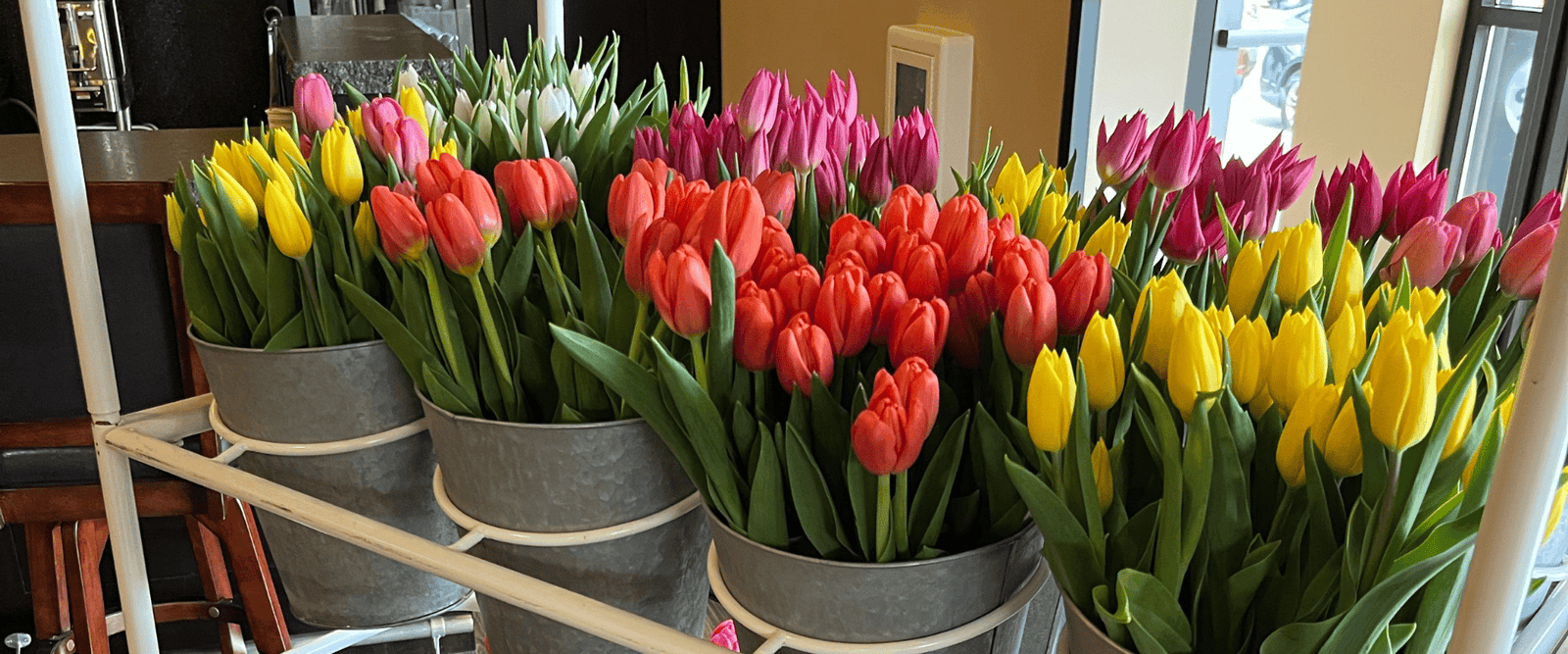
Hello, and welcome back to another episode of the Sunny Mary Meadow Podcast.
Today, we are going to talk about tulips. I am really excited about this episode because I think there’s a lot of confusion about how to grow them and how to do it best. I’m going to try to address the differences if you are growing them as a cut flower farmer and selling them commercially to customers, if you’re just giving them away as bouquets, or if you just want them in your landscaping. I think there’s a lot of information out on social media showing this process that if you grow tulips, you need to cut off the bulbs and throw them away. People are confused because they’ve been growing tulips for years. I hear it all the time, “I don’t have to do that.” I want to address what that means and what that looks like. Plus, I think tulips are the highest demand flower for me.
In year one of my business, I didn’t have any, and then that fall (you plant them in the fall and pick them in the spring), I bought 1,000 tulips. Then the following year (last year), I had about 4,500. Last fall, I bought about 11,000 or 11,500.
I recorded/wrote this on March 14, 2023, and yesterday, March 13th, was when I noticed my first tulips popping out of the ground. Remember, I’m in Zone 4B, but that was inside of my high tunnel, not outside. I covered this in another episode/post, but growing in small spaces is something that I do a lot of. Succession planting and replanting different types of flowers in the same space is how I am literally able to grow thousands (3,000-5,000) of bouquets on less than half an acre. Once the tulips are finished, I plant something else in their place. I don’t want to disturb the soil on multiple acres and use up my whole yard, and it just makes a lot more sense.

In the fall, after all of the summer plants have been killed by a frost (zinnias, my sunflowers, my cosmos, etc.), I’ll get rid of them. For the last couple of years, I’ve used an enormous weed wacker/pole saw and just kind of brushed back and forth and cut them down. Then I removed the fabric and removed the drip lines, and then I was able to dig them up that way. Some people will use a brush mower instead. Regardless, you get rid of the plants in the fall that were there, then you remove the landscape fabric (which I talked about in another episode/post), you remove the irrigation, you remove the staples, you add compost, and then you work it into the soil. Since we are growing our tulips as cut flowers, we plant them in really long trenches. It’s lots of work, but we get really healthy long-stem blooms.

So again, we’ll touch on flower farming versus gardening … if you are growing for cut flower production, you need to dig up the whole tulip, bulb, and all and harvest it that way. If you’re not, and it’s just in your garden, you can leave it just as a perennial and it’s just there. But even if you do cut it, you probably can leave it and see what happens next year. The problem with tulips is that the bulb stores its energy from the plant that died back. So, you need to let it die back naturally. Or, at the very least, if you do cut it, you really need to leave the bottom two leaves so that it can take that energy and make that for next year’s flower.

I know that’s true because, in my first year, I planted them in some really hard rocky soil. When I went to dig them up, I didn’t realize I should maybe use a potato fork, spray it with a hose, and loosen it up a little bit. I just went to pull the tulips up, thinking that they would just come up with the bulb, and the bulb snapped off on hundreds of them. I thought, “Well, it got all the way down to the bulb, whatever,” and then I just had to use them right away. I couldn’t store them (which we’ll talk about in a little bit). But the next year, they came back, and it was about three inches tall, and just leaves. That was it. There were no flowers. At all. What-so-ever. Now, I think if you cut it down to the ground, you might get a tiny flower. But again, you’re only getting an eight-inch stem that’s not long enough to put in a vase. I tried that a few times, and they’re just tiny. I would be embarrassed to sell a dozen of those in a bouquet. I wouldn’t do it, and nobody would buy those. They would be ugly.
So, when you dig them up completely and pull them up with a bulb attached to them, you are able to really lengthen that stem … it gives you an extra four or five inches at least. That just really makes it look much nicer in the vase, obviously. As I said, you can try, but if you cut them, they’re probably not going to come back very nice. At the very least, leave a couple of leaves on the bottom. Now, if I were just going to plant to make them look nice in the landscaping around my house, I would dig a little hole and put about 10 to 12 tulip bulbs in, in kind of a bunch, and let them all just come up together. Then I would leave them, let them die, and not touch them. Now, if you’re like, “Well, what if I pick a couple of them?” What I would do is have 10-12 tulips spread out every 3-4 feet around your house in your landscaping. Then in the spring, you could cut three or four of them out of each bunch and then leave like eight of them sitting in the ground blooming. Then next year, at least you’ll have eight of them blooming again, so you don’t have to completely redo it again the next year. I have people that don’t believe me (and I know this is true for every single flower farmer). “Trust me, it has been tried. It has been experimented on. If we could do it that way, we would.” I know it seems wasteful that you use it as an annual, but really, if you want tulips for cut flower production, it has to be treated that way.
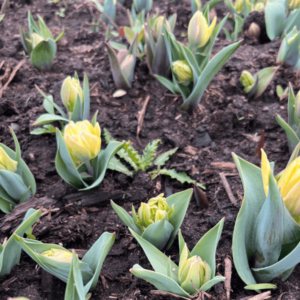
They really grow best in free-draining soil. If they get waterlogged, they will rot. I wanted to cry for my friend Amber last year. She planted them in way too low of ground, and it was just way too muddy. Last spring, she was waiting for them to come up, and two weeks after mine had started coming up, she was like, “Well, what do you mean yours are up? Mine aren’t peeking up yet.” I think we both knew it wasn’t good. She finally went to try to dig them up, and she’s like, “They are all rotten.” OMG, It’s scary. It’s nerve-racking. So again, you really want them somewhere with full sun, not somewhere that there’s going to be standing water. And they really need free draining soil because you do not want to plant them where they’re going to rot.
If you’re a flower farmer, make sure that before you dig really huge trenches, try a couple of different spots in your yard. Divide them up and figure out where they’re gonna grow best. They absolutely need full sun or as much sun as you can give them. What I do now is divide them in half (this is my first year doing this, so I don’t want to sound like I’m an expert). I did about 4,500 outside in exactly the spot where I have always grown them. Then the other half, I planted inside my high tunnel. When we planted, they were actually outside, and then I ended up building my high tunnel around them because, by the time we got the high tunnel put up, it was basically winter. Flower Farmer Fiancé did not have time to help build the high tunnel until then. I needed to get the tulips planted in the fall, so I had volunteers to help me plant them, and he built the high tunnel after they were planted.

Another way you can do it is you can make sure that they’re in long, skinny rows. Then you can actually build what we call a low tunnel – it’s a low, little mini frame. You put the stakes in the ground, and then you can put greenhouse plastic on top of them. But you have to uncover the tulips during the day when it starts warming up because they cannot cook. So, that’s another good way to do it if you don’t have a high tunnel. Ashley Vail and I talked about it in our high tunnel episode/post if you go back and reference that. You can listen/read all about high tunnels, but you can also make a little low tunnel outside to get half of your tulips to bloom. Just keep in mind that you’re really going to have to go back and forth all day uncovering and recovering because when you use a high tunnel or something for season extension, you don’t want to trick the tulips into thinking it’s the heat of summer. Otherwise, they’re going to bloom way too early, and they’re going to bloom way too short.

So, as I said, what I did was planted half of them inside of the tunnel, and those 4,500 started to peek up yesterday, on March 13th. Last year, I had tulips peeking up outside on April 8th. I checked my phone, and that’s when they started coming up last year. As of the time we were doing this episode/post, we still have so much snow on the ground and just keep getting more. I don’t think we’re gonna have tulips peeking out of the ground for a while this year. I mean, I seriously think we’re gonna have Fourth of July tulips this year! I think it’d be super late here in Zone 4, so I planted half of them inside a high tunnel and half of them outside.
Oh, another important thing to add, I know not everyone is in Zone 4. Again, when we did this episode/post of the podcast/blog, it was March 14th. And that morning, on my way to work, it was nine below the actual temperature. Nine below! It was still so cold. I hadn’t even planted my ranunculus yet, because I couldn’t; it had been freezing. But tulips need at least six weeks of cold in order to bloom. So, in some places in the south, they actually will pay extra for pre-chilled bulbs. I don’t know if they can just stick them in their freezer or what. I shouldn’t even talk about it because I don’t know. I’m humble enough to admit that I have no clue what I’m talking about when it comes to how you pre-chill them. I think they have to be in about 35-degree temps. Actually, from what I read, that’s the minimum. Because otherwise, if you just stick them in a freezer without the soil around them, it’ll be too harsh, and they can get freezer burn, and they can rot when you take them out. Regardless, if you plant them in Georgia or somewhere in the South, you need to pre-chill them.
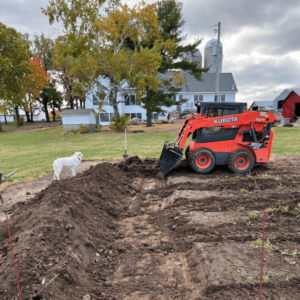
To plant them, I dig these long trenches that are three feet wide and six inches deep. I literally just pile all of the dirt to one side, I add my fertilizer or compost, and then I rake it smooth into the ground so that it’s a flat/even surface, and then we will literally take the tulip bulbs and place them pointed side up, like eggs in a carton. You want them very close together for a couple of reasons. First of all, it helps get a lot of bulbs into a small space. I planted 4,500 of them in a 3-foot by 20-foot trench. But also, when they’re really close together like that, they compete for light, and they get very tall. It makes it easier to pull them up because they all kind of come up a little bit looser.

If you are just planting them in your garden or landscaping, and you’re not picking them, cutting them, or planning to sell them, then as a rule of thumb, you’re going to plant them three times as deep as they are tall. Just keep in mind that it’s roughly six inches into the ground. One year I planted them only about four inches deep, and they were just way too shallow. They were way too short-stemmed. So, that’s something that’s really going to make them long-stemmed and look beautiful in a vase.
Once you have the bulbs all in place, you’re going to want to take a hose and water them really well, really deeply. Then you’re going to refill the hole – just take the dirt from the trench pile right next to it and cover it, try to level it as smoothly as you can (honestly, call it good … it doesn’t need to be perfect). And you walk away.
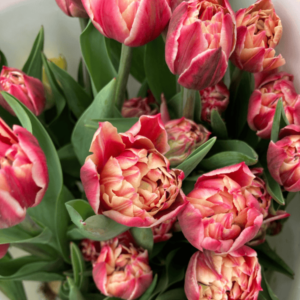
Make sure you mark the area so you know where they are. I like to take the little wire and plastic flags and mark the edges with those. You know what I’m talking about … the ones that they use when they come out and mark lines for your electricity or whatever. I also put one in the middle between the different varieties. Then I take a picture with my phone, put it on my Instagram stories, use the text box to put the variety where they are between the flags, and then I just save it to my camera roll. So, I have a digital copy of what varieties are where. That’s been really easy for me because I have a folder on my phone of everything flower farming and everything business, and I know I always plant them in late October, so I can go back and reference that. That’s been really easy for me, though that might not be how you want to do it.
You can buy longer landscaping tags or greenhouse tags (the plastic ones) or just buy some wooden stakes, and then you’ll label them. Do not use a Sharpie because that’s just going to fade away. You’re gonna want to use a paint pen. I will put a link to my stories about that, but I have done this before. I say, “Oh, don’t use a Sharpie,” but that’s how I label my dahlias in the fall before I dig them up, and within a month, the labels are gone. So make sure that if you label them, you know exactly where they’re at.

So then, for example, if they’re in my high tunnel, I wait until they’re peeking up to start watering them. Outside they’re frozen solid, and there’s snow on top of them to insulate them. I just watered the ones in the high tunnel the other day. It still freezes really hard at night inside of the tunnel, so I didn’t water them too deeply because I knew that it was nine below last night. I don’t want to freeze them. So, give them a good soaking a couple of times a week. If they’re growing commercially in fields and whatever, some people will lay drip lines on top of them. I don’t mess with that. I take the hose a couple of times a week and water them. It takes me a little bit of time, but it’s not terrible. I just don’t want to lay down the drip lines and then have to roll them back up after I’ve harvested them just to lay down more landscape fabric, plant my new seeds, and lay down more drip lines … it just seems like a lot of work. So, I just water them by hand, and it does not take that long.
Okay, I think we have everything covered when it comes to planting them.
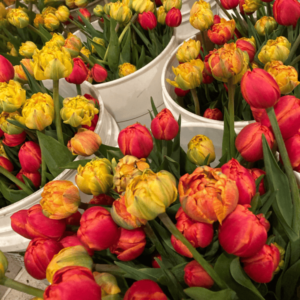
So, now we’re going to talk about harvesting them. When we harvest the tulips, we pull them up with the bulbs still attached. The reason we do this is because they are connected to their food source. That is actually a really big part of the main reason why I leave the bulb still attached. Yes, it helps with vase life. Yes, it guarantees a plump, happy tulip. But they can be stored dry for as much as three or four weeks in the cooler. I did them for three-and-a-half weeks last year, and they were great. This year, I don’t think I’ll ever really do it for more than two weeks, but you could. Basically, you pull it up with the bulb still attached, and then you can put them in crates. What I do is put them in a five-gallon bucket. I figure I can fit about 100 of them in a five-gallon bucket. So, I put them all really close together, put my hands around them, and then I lower them with the bulbs on the bottom because they’re heavy, so they’re weighted that way, and then I lower them into a five-gallon bucket. And then they all just kind of support each other, and they stay upright, and they don’t get floppy. And then I can fit about 30 of those buckets in my walk-in cooler, which is 38 degrees, and they can just stay there for weeks on end. Then when I need them, I can just cut off the bulb and stick them in the vase. So, it’s perfect. That is a huge, huge reason why we keep the bulb attached and why we harvest them that way. When I do it, I cut off the bulbs by hand, one by one. Then I hose them off really well because they’ve got some dirt on the bottom six inches that were underground. So, it just works out perfectly.
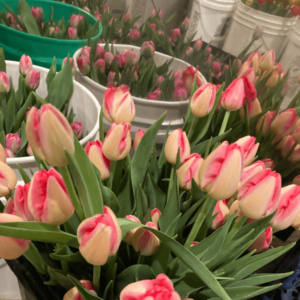
Anyway, after I’ve dug them up, it works really well for me to plant my next rows of flowers. That dirt has already been worked out because of the tulip bulbs that were pulled up.
Abbey:
I would just like to take a second to say that I, too, am constantly connected to my food source.
Liz:
Yeah, yeah, it’s important. It’s important. And aren’t you happier?
Abbey:
I am so much happier with a snack on me.
Liz: Exactly, exactly. Tulips are so much better when they’re happy or when they’ve got a snack on them. I love that.
A lot of the tulip bulbs that I plant are fancy tulips. A lot of them look like peonies. They’re big and fancy. And I love them, but sometimes they’re a little bit heavier, so they can get a little bit floppier in the vase. I’m really learning about these because I had some customers last year who were like, “They were dead.” “They were floppy.” “They were ugly.” And I was like, “No, they weren’t; they were soooo pretty, but okay…” So, I learned that I need to cut those shorter because they need to support each other a little bit, but they are so pretty. So, they just need certain types of vases. One thing that you can do is wrap them in a funnel of paper or put them in a skinny vase and kind of support them for the first 24 hours after you harvest them. Then that will really make them grow upward … and they actually can. This is interesting, but they actually continue to grow when they’re in the vase. So, they’ll grow another inch or two in the 10 days that they live. So, if you put them in an arrangement, just keep in mind that they’re going to get taller.
Another thing I wanna talk about, and I have not mastered this yet, is growing them in crates. A lot of people will do it in Minnesota and leave the crates outside. They have to be on the ground to get the natural freeze, and I messed this up. I thought they just had to freeze, not thinking about them freezing, thawing, freezing, thawing, etc., and I put them upstairs in the loft of my barn. It was like 40 pots, and I was thinking, “Oh my God, I’m a genius. I’m going to have 40 pots of tulips around Easter time. I’ll bring them inside and turn on the grow lights, and it’ll work.” Well, they all rotted, so I think that they just thawed and froze so many times that they just didn’t work on the ground like the regular tulips. Anyway, I messed up there, but you can force tulip bulbs in a crate. As I said, I’m not an expert on this, but you can look it up and see if it works for you. Who knows, maybe in a year or two, that’s something that I will do so that I can have my own tulips for Valentine’s Day. Or maybe I’ll say, “You know what, someone else can do that. And that’s just fine. And that’s very interesting that they do that. And that’s not gonna work for my business.” I try really hard to work … I shouldn’t say I try really hard … I work very smart when it comes to trying to work with Mother Nature. Maybe we’re not meant to have tulips in February, I don’t know. I just tried to find something that was available at that time.
One other thing that I should have mentioned is that I try to look at the tulip kinds that I buy; they’re labeled this when you buy them. And I know everyone’s gonna ask, “Where do you buy them? Where do you buy them?” I have an EIN with my LLC, and I have a wholesale license to buy wholesale tulips from a company. I’m not gonna tell you where I buy them. But it’s a good source.
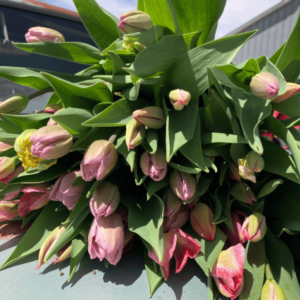
I also want to have my own tulip bulb sale locally in the fall. I think people would go crazy over the fancy tulips, and I have been selling some to subscription holders, but I would like to get it on my website and really do it. I just have to make sure that I’m doing it properly, legally, whatever that looks like. Because you actually don’t need a license to sell cut flowers or annuals in Minnesota, but you do for perennials. I would argue that these tulips are used as cut flowers, so they’re annuals, but I don’t know. I’ve gotta look at it because I don’t want to break any laws. I don’t want to go to jail or look like I’m trying to be a non-law-abiding citizen. I feel like I’m a really good citizen, so I don’t want to break the rules.
I tried to buy different varieties that are labeled early-, mid-, and late-blooming. So that they’re not all going to bloom at once. So, I planted some inside, planted some outside, and I can use my cooler. I’m really hoping … we’ll find out at the end of this season … I’m hoping to have tulips for a solid eight weeks, and that really spreads things out. I have four weeks of subscription holders. I’m probably going to start those about week two. I want to make sure I have at least two weeks’ worth in my cooler by the time I do it. I’ve been approached by a few businesses to do some little tulip stem bars and tulip events. And I’ve told them, “Probably. I’m 99% sure.” By the time this episode/post comes out, those events will be over, so we’ll see what they are. But everybody goes crazy over tulips.

The last thing I want to talk about is the varieties that I grow and the ones that I don’t grow anymore. So, the one that I don’t grow anymore, that I’m going to really miss, is called a Rasta Parrot (R-A-S-T-A parrot), but they were just so short. I did them for two years in a row, and they were just so short, but they literally look like a rainbow. I think they would be so cool in landscaping, and eventually, I will plant some in landscaping around my house, but they just do not work well as a cut flower. New to me this year is Black Hero. It’s a double Peony-looking tulip. As I said, most of mine are doubles because you can go to a Coborn’s or wherever and buy a dozen single tulips. So, I sell the fancy doubles … that’s what I sell.
For my subscriptions, I have a Tuesday, a Thursday, and a Saturday pickup. Each has 40 bouquets, so that’s 120 per week for four weeks. At the time of recording the podcast/doing this blog post, Tuesday is completely sold out. I believe Thursday has six spots left, and Saturday still has about 25 spots. We’ll see what happens; if Saturday doesn’t sell out, I might reach out to some people or might just do a post on my social media stories and say, “Hey, are you not buying because it’s Saturday? Because I can move it to Monday, or I can move it to Wednesday. I just thought I would spread it out.”

But yeah, people go crazy over the flowers. So, we’ve talked about the Rasta Parrot, and we’ve talked about Black Hero. Queen of the Night is a really, really, deep purple, but it’s a single stem. It looks like a normal tulip, but it’s just this really deep, almost black color. I’m really excited about that. I also have Mayflower, which is a mauve color, like dusty pink, and they just look beautiful together. The other varieties I have are Charming Beauty, Foxtrot, Foxy Foxtrot, Mayflower, Aveyron, and Black Hero, and then a ton of single darwin varieties with long stems.
So, a few of you asked some questions … You asked about growing them in high tunnels. You asked about what type of soil they do well in. You asked about saving the bulbs. You asked about growing them gardening versus commercially. I think we covered them all.
Liz:
Abbey, do you have any questions?
Abbey:
I have a couple.
Liz:
All right.
Abbey:
First question. How long did it take you to plant almost 10,000 tulip bulbs?
Liz:
I am SO fortunate that I have a lot of volunteers. We planted them in three days of like four or five hours a day.
Abbey:
Oh my gosh.
Liz:
There were two people that were here, well, they’re a couple, and they’re just amazing. Carol and Dan, if you’re listening … Carol and Dan are awesome. They come and help me plant, harvest, whatever. And I always try to ask, “Can I give you a bouquet? Can I give you flowers?” They’re like, “Nope. Nope. We don’t want ‘em.” They’re a married couple. I know their daughter pretty well, and they’re just awesome people. So, they come and help. And then my friend Heather has come. I’ve had … I’m drawing a blank on all the names. My friend Emily came, and Brent’s sister Shannon came one day. It really doesn’t take that long. I mean, the shoveling of it. But if three people have a shovel and you just get it ready … I did use the skid steer to dig the trench and refill it. So, it really doesn’t take as long as you think it would.

Abbey:
Next question. You mentioned something called a potato fork for harvesting … what the heck is a potato fork?
Liz:
I will put that on my website link, but it’s basically a pitchfork with wider teeth. It’s got like four teeth in it, and it’s straight instead of curved, and it’s really sharp. And I would say they’re like a half-an-inch wide, and it really just digs up the soil really well. I would say it’s a combination between a pitchfork and a shovel. It’s my favorite tool.
Abbey:
A potato fork.
Liz: It’s yellow. I will post a link to one. I’ll see where I can find a link. I don’t know if Amazon sells potato forks. I feel like I got mine at either Mimbach Fleet, or Mills Fleet Farm, or I don’t know where we got it. Probably a yard sale.
Abbey:
Perfect. That’s all I had. All of my other questions got answered throughout the podcast.
Liz:
Sounds good.
Well, thank you so much for listening. I hope this was informative. I hope it added value to tulips. I hope it made you appreciate the work that goes into them. No matter where you live, whether you’re growing them for yourself, you’re buying them from me, you’re buying them from somewhere else, you’re buying them at the grocery store, there’s just a lot of work that goes into them. But there’s a reason that they’re so desired.
Thanks for listening to/reading the Sunny Mary Meadow podcast/blog. I’m your host, Liz. If you like what you’re hearing/reading, please subscribe and rate us. You can also find us on Instagram, Pinterest, and Facebook.
You can subscribe to our email newsletter below. We love to hear any podcast-related feedback at our email podcast@sunnymarymeadow.com, and all other inquiries can be sent to liz@sunnymarymeadow.com.

